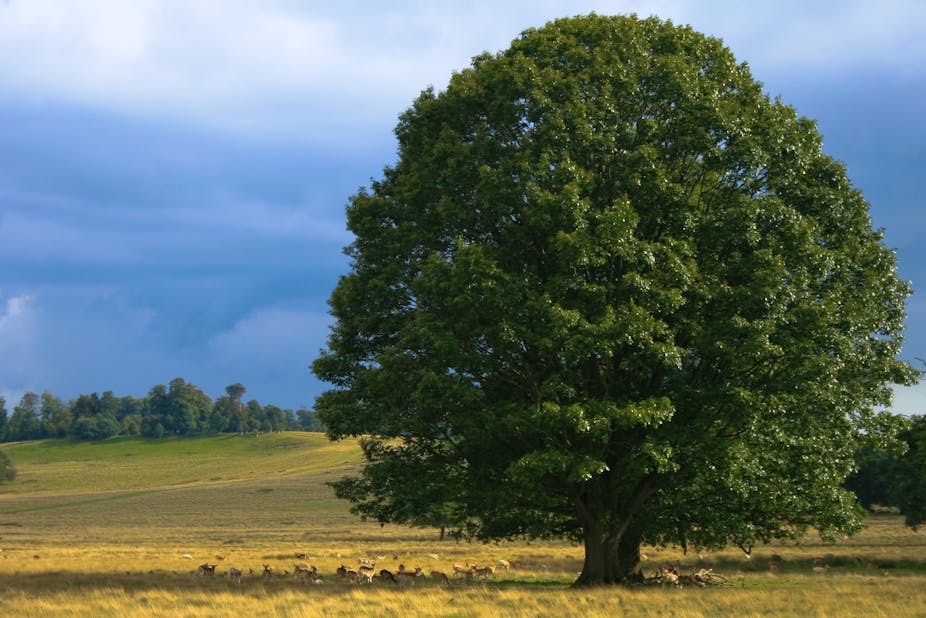Britain’s tallest tree is a 200-year-old, 44-metre high beech growing in woods in West Sussex, according to the Tree Register.
Although this incredible beech, found on the National Trust’s Devil’s Dyke estate, is slightly taller than the previous champion – another of this genus in Gloucestershire – these are not actually the tallest living trees in Britain but the tallest native trees – ones known to have been growing in Britain since the last ice age.

If we included all trees – native or those introduced at a later date – there would be others in the running. Currently the tallest tree growing in the UK is a Douglas fir growing in Reelig Glen, near Inverness which measures just over a massive 66 metres.
Height, of course, is not the only thing that can make a tree stand out. Other categories competing for most impressive tree include age and mythology. Here are four others that fit the bill.
The Major Oak: helped to rob the rich
When Nottinghamshire residents go just about anywhere in the world and explain where they live, the immediate response is “Aaah! Robin Hood!”
Famous around the world for harbouring the infamous folk hero, the “Major Oak” is one of Britain’s oldest oak trees. No one is sure exactly how old it is but estimates of 800 to 1,000-years-old mean that it has survived through at least eight centuries of change.

The major is a fine example of Quercus robur, or the English Oak, and brings thousands of tourists to Sherwood Forest every year. Sadly visitors can no longer climb inside the tree as it is now fenced off and to prevent them from falling, the massive branches are propped up on large poles.
It is debatable whether Robin and his Merry Men did actually hide inside this tree but keeping things inside it has been recorded several times during its history, initially as the “Cockpen Tree” when it was used to contain birds before a cock fight. It was only named the Major Oak in the late 1700s after Major Hayman Rooke, the local historian who described it. In the 19th century it was known for a while as the “Queen Oak”.
Bramley: the apple tree still going strong

Nottinghamshire is also home to the original Bramley apple tree. Bramleys are large, sour apples well known all over the world for their cooking quality, and they all descend from one 200-year-old tree which still exists today.
The tree was first grown from a pip in 1809 in a back garden in Southwell by a young local girl called Mary Ann Brailsford. Once the quality of the fruit had been noted in the 1860s the tree was propagated by Merryweather’s Nursery, also in Southwell.
It’s astonishing to imagine that every single Bramley apple tree across the world has been cloned from this original tree (or indeed from a clone of a clone of a clone of this original tree) originally grown from a pip so many years ago by a little girl.
Although the original was grown from seed, new Bramley apple trees are grafted onto another type of apple tree to help reproduce them.

Bramleys are also sterile, able to receive pollen but not able to pollinate other Bramleys themselves. This is because they have an extra set of chromosomes, which means they need two other different types of apple tree to pollinate – otherwise their apples won’t grow and swell.
The churchyard yew: as old as Stonehenge
We have to move along to Wales to see Britain’s oldest tree, a 5,000-year-old yew growing in St Cynog’s churchyard at Defynnog near Sennybridge, Powys.

It’s not surprising that this is a yew, as these conifers have an amazing ability to regenerate. For centuries yews have been known as the “tree of life” due to their longevity. When the centre dies away and they become hollow, the cylindrical shape of the trunk is actually amazingly strong and is still able to support the massive crown of the tree.
Yew trees have been long associated with churches and graveyards and in ancient legends they were associated with immortality. In Wales the tradition of the yew as such a symbol is linked with ancient Druid beliefs and customs, and was often a meeting place where rituals and festivities took place.
Majesty Oak: the hollow giant

Finally, the award for the tree with the widest trunk goes to another English Oak with an amazing 12-metre circumference. This tree is known as the “Majesty” and is growing in Fredville Park, in Kent. Although the tree is completely hollow, the trunk has not split.
One journal entry recorded a visit to the tree in 1793:
Call on John Plumtree, Esq. of Fredville, who very politely shews us his famous oak, called Majesty - measure this tree; 4 feet from the ground the circumference is 31 feet; it is supposed to contain from 36 to 42 tons of timber. Two branches separated from this tree about four years ago, in a calm day, which contained three tons of timber. Another oak, called Beauty, 14 tons of timber; girt, 4 feet from the ground, 16 feet 4 inches, is 63 feet high, perfectly straight, and a beauty indeed!

